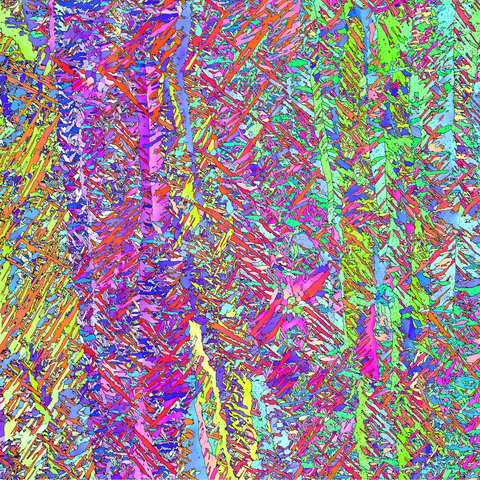

These images scream “manufacturing,” right? For NIST’s Jake Benzing, they certainly do.
With an electron microscope by his side, the NRC postdoctoral fellow creates scans like these for 3D-printed cubes made from different metal alloys. The cubes come from a process called additive manufacturing, which builds up a 3D shape from thin layers of metal powder, each melted into place by a laser or electron beam. Engineers want to control and understand the additive manufacturing process as much as possible, so that their creations can handle the real-world stresses that they’re supposed to withstand.
Jake develops maps of the 3D-printed cube samples’ microscopic structure. The method (called electron backscatter diffraction) fires an electron beam into the surface of the sample and detects a specific pattern for the individual metallic grains inside.
Each grain’s pattern visually reveals how it will respond to an applied force. In the images that Jake renders, the color of each pixel represents a grain’s orientation and crystalline structure. Combining all the colors together gives a comprehensive look at the properties in different sections of the material.
The details of the manufacturing process — from the energy of the electron beam to the time it takes for each metal layer to melt into the desired shape — all factor into the way the final product performs under pressure. For example, exactly how much stress will cause the parts of a jet engine to expand under the stress of centrifugal force while up in the air?
At such a detailed level, manufacturers can narrow down which 3D-printing process best suits their needs for a particular product. As you can see, the result can be easy on the eyes, too.
Find out more about Jake’s research:
- Effects of laser-energy density and build orientation on the structure–property relationships in as-built Inconel 718 manufactured by laser powder bed fusion
- Tracking defects and microstructural heterogeneities in meso-scale tensile specimens excised from additively manufactured parts
- Hot isostatic pressing (HIP) to achieve isotropic microstructure and retain as-built strength in additive manufacturing titanium alloy (Ti-6Al-4V)
Follow us on social media for more like this from all across NIST!

